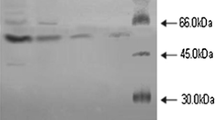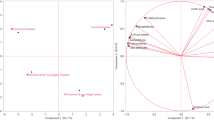Abstract
The flavor and taste of coffee are affected by roasting conditions and extraction temperature. This study assessed changes in the flavors and tastes of coffee extracted from Vietnamese Robusta with different roasting times and temperatures, as well as different extraction temperatures. Vietnamese Robusta green beans were roasted for different times ranging from 5 to 20 min and at different temperatures ranging from 100 to 250°C. The roasted coffee was then extracted at five different temperatures ranging from 90 to 120°C. The coffee flavor was evaluated in terms of 5 key odorants: guaiacol; 4-ethylguaiacol; 2-ethyl-3,5-dimethylpyrazine; 2,3-diethyl-5-methylpyrazine, and 2-furfuryl. The taste of coffee was evaluated in terms of 6 main compounds that confer bitterness and sourness: caffeine, trigonelline, chlorogenic acid and citric acid, acetic acid, formic acid. The optimized roasting and extracting conditions were identified that 200 g of VN Robusta green beans, roasting at 230°C for 18 min, and then extracted with Espresso Machine at 110°C.
Similar content being viewed by others
References
Coffeeresearch.org, Science, Bitter Chemistry. http://www.coffeeresearch.org.
Coffeeresearch.org, Science, Acid Chemistry. http://www.coffeeresearch.org.
Coffeeresearch.org, Science, Aroma Chemistry. http://www.coffeeresearch.org.
Clarke, R. J. and O. G. Vitzthum (2001) World Agriculture Series. pp. 18–107. In: Harmut H. Balzer, Allan G. W. Bradbury, Rudolf Eggers, Werner Grosch, Selichi Homma, Marino Petracco, and Arne Pietsch (eds.). Coffee: Recent developments. Blackwell Science, Oxford, UK.
Florian Mayer and Werner Grosch (2001) Aroma simulation in the basis of the odorant composition of roasted coffee headspace. Flavor and Fragrance J. 16: 180–190.
Sandriel Trindade Alves and Rafael Carlos Eloy Dias e Marta de Toledo Benassi (2006) HPLC analysis of nicotinic acid, trigonelline, chlorogenic acid and caffeine in roasted coffee. Quim. Nova. 29: 1164–1168.
McCamey, D. A., T. M. Thorpe, and J. P. McCarthy (1990) Coffee bitterness. Developments in Food Sci. 25: 169–182.
Oliver Frank, Simone Blumberg, Christof Kunert, Gerhard Zehentbauer, and Thomas Hofman (2007) Structure determination and sensory analysis of Bitter-Tasting 4-vinylcatechol oligomers and their identification in roasted coffee by means of LCMS/MS. J. Agric. Food Chem. 55: 1945–1954.
Carla Isabel Rodriguesa, Liliana Martaa, Rodrigo Maiaa, Marco Mirandab, Miguel Ribeirinhob, and Cristina Máguasa (2007) Application of solid-phase extraction to brewed coffee caffeine and organic acid determination by UV/HPLC. J. Food Comp. Anal. 20: 440–448.
Casal, M. Beatriz Oliveira, and A. Margarida (1999) HPLC/diode-array applied to the thermal degradation of trigonelline, nicotinic acid and caffeine in coffee. Food Chem. 68: 481–485.
Thomas A. Eisele and Melinda J. Semon (2006) Best estimated aroma and taste detection threshold for guaiacol in water and apple juice. J. Food Sci. 70: 267–269.
Ivon Flament and Yvonne Bessière-Thomas (2002) Coffee Flavor Chemistry. pp. 37–52. John Wiley and Sons, West Sussex, England.
Laura Maeztu, Cristina Sanz, Susana Andueza, M. Paz De Pena, Jose Bello, and Concepcion Cid (2001) Characterization of espresso coffee aroma by static headspace GC-MS and sensory flavor profile. J. Agric. Food Chem. 49: 5437–5444.
Isabel Loa Pez-Galilea, Nicole Fournier, Concepcioa N. Cid, and Elisabeth Guichard (2006) Changes in headspace volatile concentrations of coffee brews caused by the roasting process and the brewing procedure. J. Agric. Food Chem. 54: 8560–8566.
Ewa Nebesny and Grazyna Budryn (2006) Evaluation of sensory attributes of coffee brews from robusta coffee roasted under different conditions. Eur. Food Res. Technol. 224: 159–165.
Author information
Authors and Affiliations
Corresponding author
Rights and permissions
About this article
Cite this article
Nguyen, T.N.H., Byun, S.Y. Combined changes of process conditions improved aromatic properties of Vietnamese Robusta. Biotechnol Bioproc E 18, 248–256 (2013). https://doi.org/10.1007/s12257-012-0389-3
Received:
Revised:
Accepted:
Published:
Issue Date:
DOI: https://doi.org/10.1007/s12257-012-0389-3




